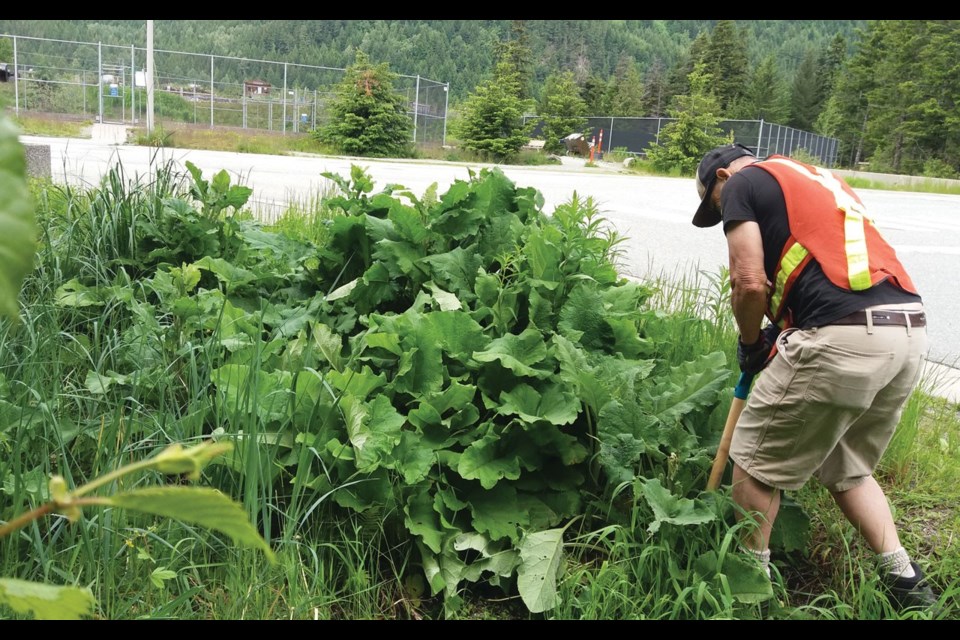Climbing down through bramble into the deep, wet shadows of a ditch beneath an overhanging cedar, the first thing I see is a 20-dollar bill.
Even partially embedded in an alluvium of winter gravel washed from a parking lot above, it sticks out like a sore thumb—an iridescent smudge of colour in a palette of slate, black and chestnut. Though a veritable treasure compared to the discards I usually encounter—beer cans, packaging, more bags of dog shit than seems possible—and mute compensation for a filth-ridden mission, I don't reach for it right away. Instead, I push a shovel into the ground at my feet. Using my weight to sink the blade deep into a matrix of rock and mud, when it can go no further I lean back, prying hard until I hear a distinct, mud-muffled pop.
Leaning over, I grasp the massive burdock plant ahead of my spade by its thick stem and pull slowly. Severed two-thirds of the way down, out comes an impressive, multi-year root the size of my forearm, a tuber that doubtless contributed thousands of propagules to the seed bank in this soil, which, even after removing the source, will continue to sprout baby burdocks for years. Hefting this three-kilogram, two-metre-tall plant like a trophy fish, the moment of environmental justice is so satisfying I almost forget to grab the $20... almost.
Life on the Burdock Patrol. My partner and I began digging up the pugnacious invasive last year as part of the Sea to Sky Invasive Species Council's Adopt-a-Trail Program. Quickly expanding into a de facto neighbourhood watch around Creekside and Cheakamus community gardens, it has continued—with admitted fanaticism on my part—through the COVID lockdown this spring, aided in no small part by time on our hands, the provision of daily exercise, and that it's far easier to coax these tenacious growths from soft, rain-soaked substrates than the sunbaked terra of summer.
Common burdock, Arctium minus (a.k.a. wild rhubarb, albeit inedible and unrelated), is a member of the sunflower family native to Europe. Now established throughout North America, though the plant itself has no sinister intent, it is nevertheless a serious problem. If you have a patch in your yard, strata, neighbourhood, or favourite trail, you know what I mean.
A tap-rooted biennial that reproduces by seed (as opposed to runners), during its first year of growth burdock forms a rosette of large, dark green, heart-shaped leaves with the broadest at its base. Plants typically bolt in their second year (usually later in Whistler) and can grow one to three metres tall. The not-unappealing pink, lavender, or purple flowers are compact (1.5 centimetres), numerous, and borne mostly at branch ends. Once done, flowerheads become enclosed in a familiar prickly bur whose hooked spines (the model for Velcro) attach to anything that brushes them, breaking off to scatter the seeds they contain. A single plant can produce up to 60,000 seeds.
Most burs fall where they grow, leading to massive infestations. But burdock easily spreads to new areas via burs that cling to passing animals—humans included. In Whistler, this means (primarily) off-leash dogs, bears, hikers, and mountain bikers. Each of these vectors is represented by burdock growing along trails (particularly junctions), roadsides, embankments, ditches, drainage areas, and in wildlife usage areas, industrial dumps, vacant lots and derelict yards (a Creekside specialty). Virtually indestructible, many pay burdock little attention, casually cutting or mowing it with the result of both keeping it alive to seed later, and widely scattering seeds from past years.
As with most invasives, once established in an area, burdock is almost impossible to eliminate. But reducing it to non-nuisance levels is not only possible, but desirable, as the plant presents a number of concerns. First, burdock hosts powdery mildew and root-rot that can spread to garden plants—especially foods. It's a hazard for animals, making life miserable for pets or wildlife that get a face-full of burs and potentially entrapping bats (actually documented in Whistler). Burs can also cause eye disease, mouth sores and skin infections in animals and localized allergic reactions for people. Worse, burdock does what invasives do best, taking over and crowding out native plants through a combination of shading and releasing chemicals that inhibit the growth of everything except, of course, more burdock. It also displays impressive "plant intelligence," growing through, around, between and under gravel, rocks, patio stones, and pavement, making it difficult to dislodge.
After cutting and digging two metric tons of seed-bearing burdock plants in Creekside last year and removing a metric ton of roots (40 garbage bags of 25 kg each) so far this spring, we've learned some things. On the amusing side: burdock grows best in association with fellow Europeans—plants, snails, slugs and earthworms. On the not-so-amusing side, although ssisc.ca/invasives/how-to offers an excellent primer on burdock removal, we now know that partial roots left in or on the ground happily regrow more burdock until energy stores are exhausted; thus, ensuring disposal of both roots and flowers/burs in household garbage (not compost) are key. We're also more careful when pulling roots, as we've observed soil disturbance promote germination in the seed bank it contains. Finally, we've learned to take any rewards where we can get them—whether simple satisfaction or an unexpected $20 worth of Coast Mountain beer.
Leslie Anthony is a Whistler-based author, editor, biologist and bon vivant who has never met a mountain he didn't like.




